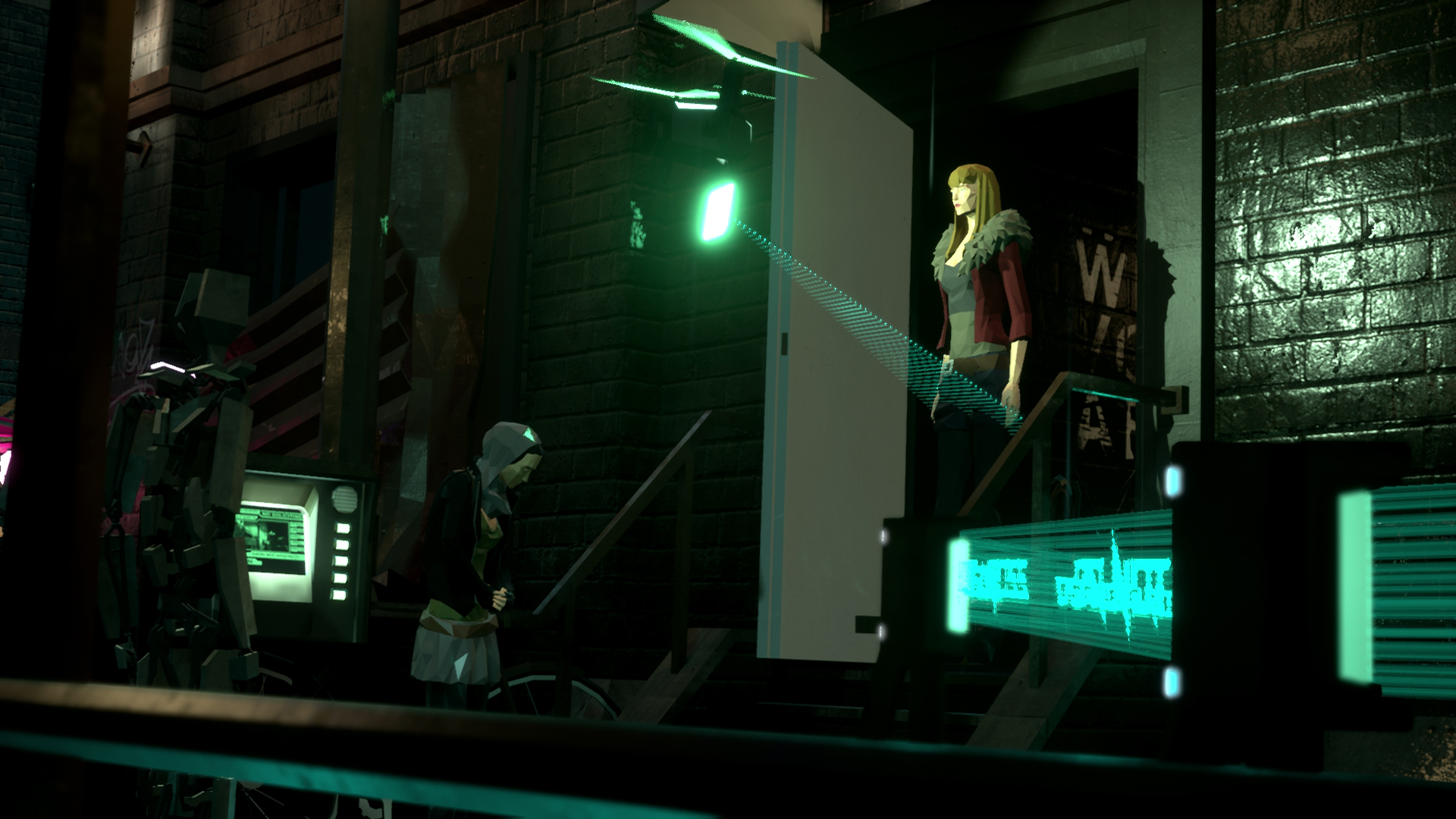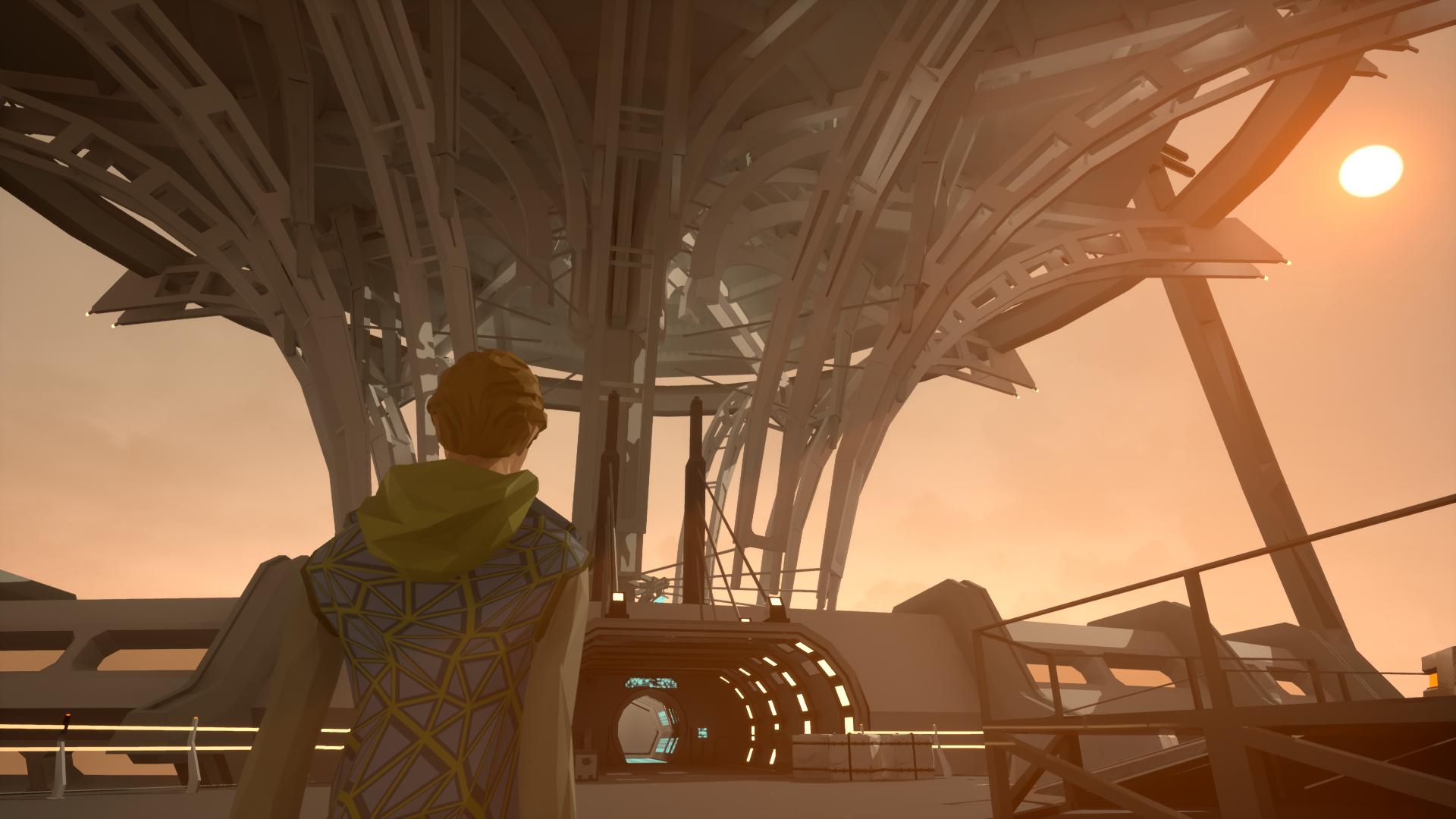July 10, 2018
Exploring a unique approach to story and gameplay in Daedalic’s ‘State of Mind’

The ever-increasing role of technology in our daily lives has dramatically altered how we function as a society. To some, it is at the core of our advancement towards a highly-optimized and universally beneficial utopia. To others, an over-reliance on technology means a compromised future and, perhaps, a threat to humanity for all.
These possibilities are usually tackled from the broader perspective of society as a whole, but the team at Daedalic is more interested in how they can potentially impact us on an individual level. In State of Mind, you experience a dystopian future through the eyes of lead character Richard Nolan as you embark on a quest to put the fragmented pieces of your existence back together.
While State of Mind’s distinct visual style has allowed it to become instantly recognizable, what exactly players can expect from this unique experience in terms of story and gameplay has remained somewhat of a mystery throughout development.
I recently caught up with State of Mind’s author, Martin Ganteföhr of Daedalic, to discuss these aspects of State of Mind and to find out more about the role Unreal Engine has played in bringing the project to life. Thanks for joining me, Martin! State of Mind certainly has an interesting premise. Can you please give us an overview of the game’s story and what inspired your team to create it?
Yes, but without spoiling too much. :) State of Mind is a high-tech thriller game on the subject of transhumanism. It is set in the year 2048, and it tells the story of Berlin-based journalist and father Richard Nolan. Early on in the game, Richard finds himself in a dire situation after a serious accident. He has memory problems, his wife and son have gone missing, his career is collapsing - he is literally a broken man. But, as it soon becomes apparent, Richard’s situation isn’t just a result of unfortunate circumstances. It isn’t fate that has conspired against him. Something fundamentally more unsettling is going on. Upon realizing this, Richard sets out on a dramatic journey to reunite with his family, to put himself back together, and to find the truth. To do so, he must find out what happened to him and why.
As far as inspiration goes, my main sources are certainly the theories and predictions made by transhumanist writers and thinkers. It’s probably safe to say that transhumanism has become the most influential belief system in the high-tech circles of the Silicon Valley. Some fantastically escapist and utopian ideas rest on the belief in exponential, radical developments in the fields of artificial intelligence, nanotech, and bio-engineering. It’s a tempting, alluring future for sure, predicted and pursued by some of the smartest, richest and most influential people on the planet. So, what could possibly go wrong? That is the game’s inciting question.

The game takes place in Berlin during the year 2048? Why Berlin? Is there something specific about the city that influenced the setting for State of Mind?
I wanted the game to play out in a major city because I think that’s where all future developments regarding technology and society will have the biggest impact. You can clearly see today that more and more people are living in cities, while smaller villages and rural areas are being abandoned. Almost every country has big cities or areas where changes are happening quicker, where technology gets adapted sooner, where start-ups disrupt the status quo earlier. For me, living in Germany and with Daedalic as a German developer and publisher, it was pretty obvious to choose Berlin since it is close to us. We know it and we can be authentic when we tell a story playing out there. Also, maybe more importantly, Berlin is interesting as a place supporting the game’s underlying theme. Berlin has a history as a divided city, with all the personal and political drama that’s been brought about. In the game, there’s the lead character’s story about dividedness (Richard’s split self, his broken family). And then, obviously, there’s the dividedness of the two game worlds.
So, yeah, Berlin seemed to be a perfect fit on many levels.
What can you tell us about the main character, Richard Nolan, and his motivations as both a journalist and individual looking to survive a world torn by dystopian reality and digital utopia?
Richard’s central motivation is certainly that of “putting himself and his life back together.” His life is lying in shards at the beginning of the game and putting the pieces back together is his strongest desire. To that extent, Richard’s profession is actually very much connected to his personal journey. Piecing together a story from researched fragments, revealing a bigger picture, finding the truth - that’s what he’d been doing as a journalist, and that is exactly what the players will be doing together with him in-game.
On a more abstract level, I feel that Richard’s crisis as both a person and a journalist is also a reflection of the world around him. Where the very concept of “reality” is in dissolution, where there’s alternative worlds, and alternative forms of existence, it is becoming increasingly difficult to find, or even define, “the truth.”

State of Mind has a gorgeous, unique art style that makes the game instantly recognizable. Did you start with this approach to the art style or did it evolve from various iterations?
Getting to the point where the art style looks as it does now was a longer process of course. We tried several different concepts and a lot of drafts ended up in the trash. I think that’s totally normal for almost any visual project. Right from the beginning it was clear that we didn’t want State of Mind to have a super-realistic look. We are not saying “this is what the world will be like in 2048.” The game is offering one possible scenario. The art style is supporting that with the semi-realistic look. Also, the story of the game is dealing with characters who are searching for something; they have questions and they are split up between their own reality and a virtual utopia. The fragmented look of the characters symbolizes that conflict between both worlds and the inner fights people fight in that scenario. Ultimately, this is a game about fragmentation and shards, and the sharded look reflects that well, I think.
Let’s talk about the gameplay. What will players actually be doing from moment to moment in State of Mind?
That's not so easy to explain. State of Mind is a sci-fi thriller. It has a whole variety of gameplay elements, but the strongest element is probably investigative gameplay. Players must discover what happened to Richard and his family, and they will do so by engaging in dialogue, using items, operating tools and devices, and occasionally switching between different characters. First and foremost, we’re aiming to put you on an emotional journey, with dramatic moments that you didn’t see coming and gameplay tasks that you didn’t anticipate. To that extent, the game’s central puzzle lies in its narrative.

Are there any unique gameplay elements or mechanics that State of Mind is bringing to the action/adventure genre?
It is unique in the way we try to tell the story. You are playing in two worlds with six characters, and two of them need to team up to discover the truth about the past and future. Richard’s core objective of “putting himself together” is actually reflected by the game’s structure. It is a fragmented story, one with multiple vantage points, with jumps between locations, between characters, and in narrated time. Richard’s state of mind is quite literally one of fragmentation. Thus, piecing the story together is what he does and what we do with him.
You’ve shown State of Mind at several events. What has reaction been like from players and how have you incorporated their feedback into the final version of the game?
The feedback so far has been very positive. The initial hook is certainly the visual style. That’s definitely what makes players curious. Once people learn about the story and the overall setting, it is interesting to see that almost everybody has an opinion about the reality in the game, because they realize it is their own possible future. Oftentimes that sparks a lot of discussion and that’s exactly what we are trying to achieve with the game.
Regarding direct feedback in terms of beta-testing, that is not something we usually do on a show floor. We do a lot of internal and external testing and we let experienced reviewers play the game prior to the release. We certainly take feedback from public events into account, but it’s incorporated into the internal feedback processes, where things are being evaluated on a more controlled and systematic basis.

How has Unreal Engine helped your team throughout development of this multi-platform title?
It helped a lot. We worked on six stock keeping units simultaneously: PC, Mac, Linux, PS4, Xbox One and Switch. This was only possible because of the excellent integration of the SDKs and the multi-platform support of Unreal Engine. When you put some thought into UI and gameplay for different platforms upfront, the porting then works like a charm.
With respect to the graphical power of the engine, Unreal is an artist’s dream come true. There are more options in the engine than Millers in the yellow pages. :) You can create outstanding-looking games with it. We created the trademark look for State of Mind without ever worrying about any limitations.
In terms of multi-platform development, the Blueprint system sped up the iteration process significantly. It’s easy to adapt to for programmers or scripters, they can jump right into production in no time. Also, with the system being so intuitive, sound engineers, 3D artists or level designers can work on many tasks without the help of a scripter or programmer. In the same way, FX artists benefit from the Blueprint system and the built-in particle system.

Are there any specific aspects of Unreal that have been particularly useful?
There are many, but what stands out for us is the immense productivity Unreal provides. State of Mind is a story-driven game, and we needed a way to have fast iterations. Also, we wanted to tell a story big in scope - thus we needed a powerful and easy way to stage scenes, change dialogues or create cut-scenes within the engine. Sequencer is a powerful tool for both cut-scenes and staging. In fact, we made all our cut-scenes with it, as well as the entire staging. We’re super happy that you expanded the featureset for the tool! We’re sure we will use it to its extremes in the future; we’re already developing new ideas of how to use it.
Thanks for your time! When will State of Mind be released and where can people go to learn more about the game?
The release date for the game is the 16th of August 2018, on all platforms. You can pre-order State of Mind for PC on Steam and GOG right now! We will share updates and new assets on our Reddit page on a regular basis, and of course, you can also follow Daedalic on Facebook or Twitter.